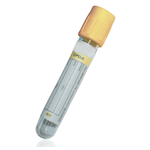Suitable Specimen Types
- Serum
- EDTA Plasma
- Li Hep Plasma
Sample Processing in Laboratory
UsualSample Preparation
CentrifugeTurnaround Time
7 daysSample Stability
Stable at 4 ºC for up to five days. For longer periods store the serum at -20 ºC.Cancer Antigen 125 (CA 125)
General Information
The CA-125 (Cancer Antigen 125) assay uses a monoclonal antibodies that are relatively specific for surface antigen derived from a papillary serous cystadenocarcinoma. It is detectable in adult pleura, pericardium and peritoneum. It is used primarily as a marker for cancer of the ovary.
Elevated CA-125 levels can also be seen in association with malignancies of breast, cervix, uterus, liver, pancreas, stomach, colo-rectum and lung.
Non-malignant elevations of CA 125 have been reported for ascites, cirrhosis, hepatitis, pancreatitis, fibroids, endometriosis, ovarian cysts, first trimester pregnancy and pelvic inflammatory disease.
CA-125 is therefore useful as an aid in detection of residual or recurrent ovarian cancer in patients that have undergone first-line therapy, or for serial measurement in patient management.
Recent NICE guidance has stated that CA-125 should be requested in primary care in women – especially those over 50 years old – who present with symptoms suggestive of ovarian cancer (e.g. bloating or distension, feeling full (early satiety) and/or loss of appetite, pelvic or abdominal pain, increased urinary urgency and/or frequency) providing that symptoms are continous and presistent (i.e. more than 12 times a month)
Patient Preparation
Samples from patients receiving high biotin doses (i.e. >5 mg/day) should be taken at least 8 hours post dose.
Please inform the laboratory if the patient has been treated with monoclonal mouse antibodies or may have received them for diagnostic purposes.
Notes
Samples should be clot free and free of red blood cells or other particulate matter. The presence of fibrin may cause erroneous results.
Pathology Harmony have recently issued guidance on appropriate tumour marker requesting. For information please click on the following link:
http://www.pathologyharmony.co.uk/harmony-bookmark-v7.pdf
If you would like some copies of the bookmark please contact the Duty Biochemist (bleep 2506).
Reference Range
Population Reference Range used historically at BHH < 30 kU/L.
Manufacturers reference data. Roche Diagnostics June 2006:
593 pre- and post-menopausal healthy females yielded a 95th centile value of 35 kU/L.
It is suggested that a value of > 35 kU/L indicates that disease may still be present when used in the context of detection of residual or recurrent ovarian carcinoma following first line treatment.
Specifications
- EQA Scheme?: Yes
- EQA Status: NEQAS
